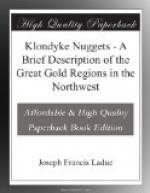“Thirty miles or so above the forks on the other branch there are falls, which McDonald estimated to be from one to two hundred feet in height. I met several parties who had seen these falls, and they corroborate this estimate of their height. McDonald went on past the falls to the head of this branch and found terraced gravel hills to the west and north; he crossed them to the north and found a river flowing northward. On this he embarked on a raft and floated down it for a day or two, thinking it would turn to the west and join the Stewart, but finding it still continuing north, and acquiring too much volume to be any of the branches he had seen while passing up the Stewart, he returned to the point of his departure, and after prospecting among the hills around the head of the river, he started westward, crossing a high range of mountains composed principally of shales with many thin seams of what he called quartz, ranging from one to six inches in thickness.
“On the west side of this range he found a river flowing out of what he called Mayhew Lake, and crossing this got to the head of Beaver River, which he descended as before mentioned.
“It is probable the river flowing northwards, on which he made a journey and returned, was a branch of Peel River. He described the timber on the gravel terraces of the watershed as small and open. He was alone in this unknown wilderness all summer, not seeing even any of the natives. There are few men so constituted as to be capable of isolating themselves in such a manner. Judging from all I could learn it is probable a light-draught steamboat could navigate nearly all of Stewart Iver and its tributaries.
“From Stewart River to the site of Fort Reliance,[10] seventy-three and a quarter miles, the Yukon is broad and full of islands. The average width is between a half and three quarters of a mile, but there are many expansions where it is over a mile in breadth; however, in these places it cannot be said that the waterway is wider than at other parts of the river, the islands being so large and numerous. In this reach no streams of any importance enter.
[Footnote 10: This was at one time a trading post occupied by Messrs. Harper & McQuestion.]
“About thirteen miles below Stewart River a large valley joins that of the river, but the stream occupying it is only a large creek. This agrees in position with what has been called Sixty Mile Creek, which was supposed to be about that distance above Fort Reliance, but it does not agree with descriptions which I received of it; moreover as Sixty Mile Creek is known to be a stream of considerable length, this creek would not answer its description.




